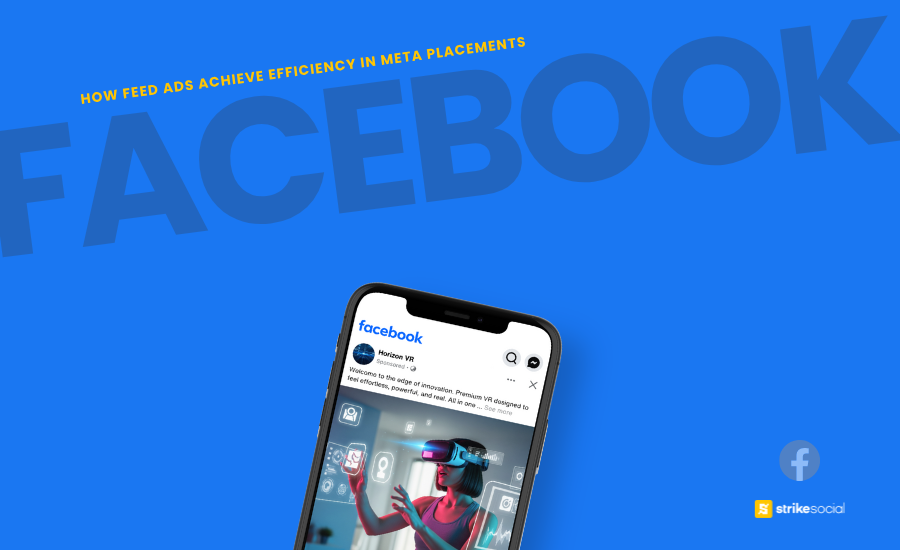Strike Overview
- Facebook Feed ads remain a top-performing placement in 2025, combining unmatched reach with strong cost efficiency and a 152% lift in link click-through rate compared to other placements.
- We unpack why ad placements on Facebook Feed drive consistent performance, from evolving ad density and inventory structure to how user behavior impacts delivery, spend, and creative success.
- Backed by internal tests and nearly 60M impressions’ worth of campaign data, this report gives you practical fixes, safe-zone creative guidelines, and strategic insights to help turn Feed scrolls into high-value clicks.
Jump to Section
- Anatomy of a Facebook Feed Ad
- What to Do When Facebook Feed Ads Won’t Deliver
- Feed: Still the Centerpiece of Facebook Ads? Is it Still Effective?
- Winning Strategies for Feed Ads
- What Facebook Feed Items Tell Us About Ad Density, Brand Saturation, and Spend
- Why the Facebook Feed Remains a Crucial Ad Placement
Inside the Efficiency of Facebook Feed Ads in Meta’s Auction
The modern battle cry of any Facebook user, “Our Facebook Feeds are all ads!” Therefore, our team took on the challenge, reviewed our personal Facebook feeds, and checked how many ads we encountered. If you are curious about the results, then you should stick around.
Ad density on feeds has been a long-standing issue for Facebook users. An online article shows that the ad load on our Facebook feed was 20%. For advertisers, this means Meta offers more ad spaces for quality inventory that will help reach more eyes or improve ad cost efficiency. Based on our Q1 2025 Facebook benchmark reports, Facebook Feed ads remain the platform’s most scalable placement. However, heightened placement competition penalizes weak assets, poor audience targeting, or oversight on campaign management.
Understanding the current content structure in the Feed section, ad specifications, 2025 overview on Facebook costs, and Feed ads performance for Traffic campaigns will help advertisers address a decline in campaign performance or overcome a plateau.Whether you implement manual bidding for maximum control or enhance campaign performance through AI automation, Advantage+ products, and a comprehensive understanding of Feed ads, your campaign outcome can be influenced by these factors.
Anatomy of a Facebook Feed Ad (2025 Edition)
What exactly is a Facebook feed ad?
A Facebook Feed Ad (sometimes called an “in-feed” or “newsfeed” ad) is any sponsored post that appears natively between organic content in the main scrolling area on mobile or desktop. Delivery is auction-based, measured by CPM for costs, impressions, and reach metrics. When a user refreshes the feed, Meta’s algorithm evaluates each eligible ad’s bid, predicted action rate, and estimated ad quality to determine which creative secures the slot.
Creative formats available for Facebook Feeds
Choosing the proper creative format is just as important as setting the campaign goal. The selected assets impact how your message is delivered, audience engagement, and retention. By thoughtfully selecting a creative approach, you enhance the chances of the target audience resonating with the ads, ultimately driving better results.
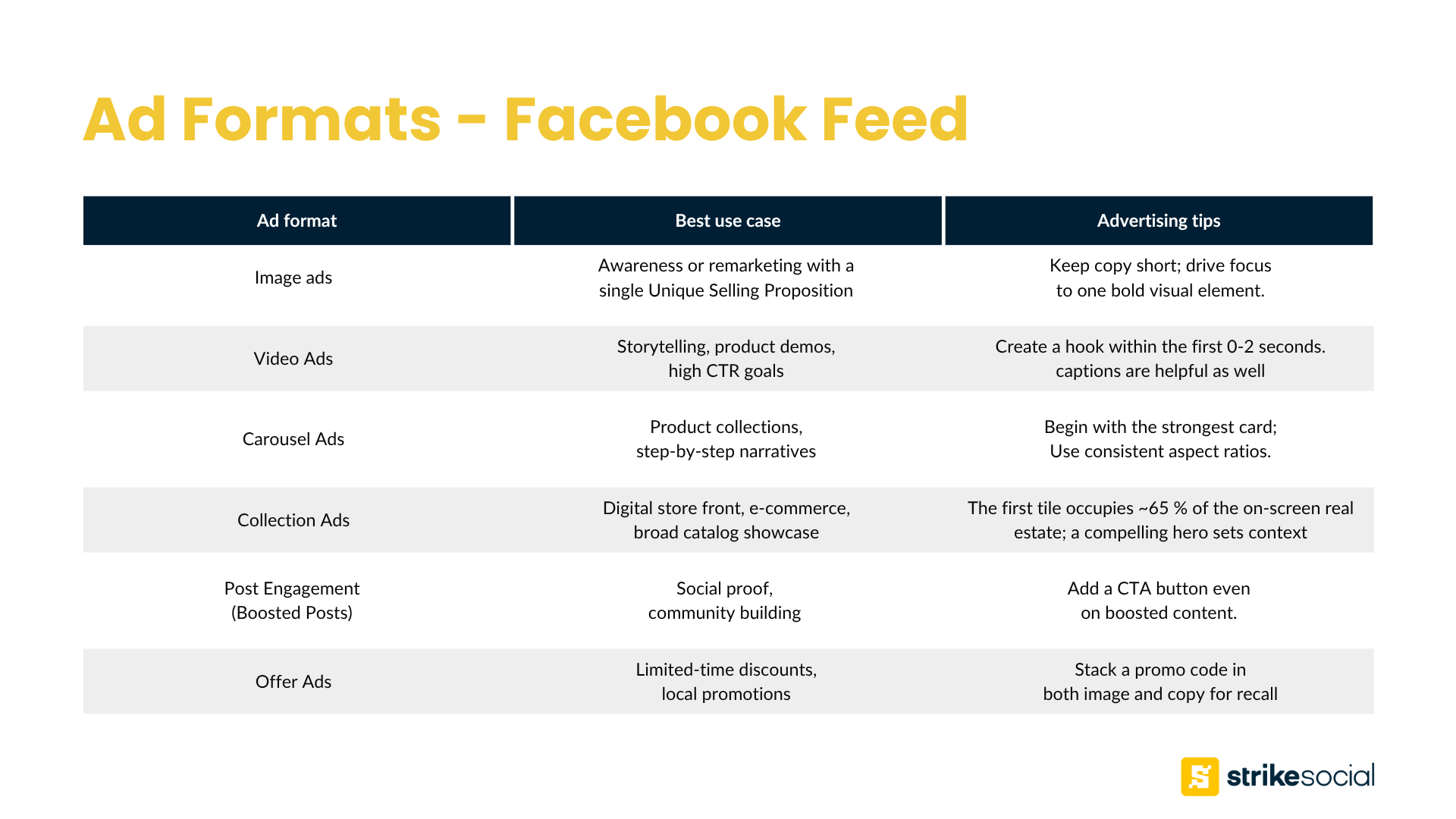
These formats are optimized for the Facebook Feed and are the most common ad types users encounter while scrolling through their main Facebook timeline. For specific ad specs, refer to our 2025 Facebook guide.
My Facebook Feed Ads Won’t Deliver
The creative setup initiates the process, while the effectiveness of the delivery determines whether the strategy is viable. The following outlines critical factors that distinguish whether a campaign struggles to spend or is on the right track to achieve the target goal.
- Ad Load Caps
- Pre-campaign launch: Meta applies soft frequency governors that vary according to predicted creative fatigue that may occur in the first week of the campaign.
- During campaign flight: Meta detects frequency, and if your target audience has hit the limit, the media buyer will see a Creative limited or Creative fatigue status. This includes, if the cost per result exceeds that of your previous ads but is not more than double, a Creative limited status will be displayed.
- Action points for media buyers: Create an additional ad with new visuals while keeping the original running. Consider expanding your audience targeting for fresh perspectives on the creative. To streamline the process, enable Advantage+ Creative, allowing Meta to generate variations for different target audiences automatically.
- Facebook Inventory Filter Impact
- Opting for a limited inventory strategy can reduce impression volume by as much as 30% in sensitive industries, such as food and beverage (F&B) and pharmaceuticals. However, this approach also decreases the risk of brand safety issues, making it a strategic choice for businesses operating in sensitive industries.
- Action points for media buyers: Run two identical ad sets for 3 days: one Standard and one Limited. Keep the Limited set only if the increased brand safety justifies the 10-20% higher CPM than set benchmarks.
Feed: Still the Centerpiece of Facebook Ads? Is it Still Effective?
The most “tenured” placement may have been the Feed, but even amidst the excitement surrounding video-centric placements like Reels and Stories, the humble Feed remains Meta’s engine room.
Based on our Facebook US campaign data, which leverages link clicks from January to May 2025 (nearly 60M impressions and over 18 different placements), it shows that the Feed accounts for almost 20% of total ad spending and receives the second highest allocation, next to Facebook Overlay Reels ads.
Here’s why that hasn’t changed and what it means for your media plan.
Unmatched Unique Reach and Diverse Content Inventory on Feed
According to Strike Social’s internal Facebook report from 2025, the top five ad placements with the highest spending are Facebook Reels Overlay, Instagram Stories, Instream Video, Instagram Feed, and Facebook Feed. Among these, the Feed ad placement has the greatest unique reach and reach/impressions, standing at 92.5%.
Amongst all the different ad placements within Facebook, Feed also offers the most dynamic content and access to different sections, namely:
- Group post: Organic content published inside a Facebook Group.
- Friend post (organic): Post from a user you’re connected to.
- Creator post (public profile or Digital Creator page): Organic or branded-content post from a Creator profile.
- Your post (self-authored): The content you publish.
- Page post (organic): Update from a business, brand, or public Page that you follow.
- Reels carousel in Feed: Horizontal scroll unit that previews short-form Reels.
- Stories tray: Bubbles at the top of Feed; includes Your Story, Friends’ Stories, and Memories Story re-shares.
- Threads cross-link unit: A prompt that encourages users to check out conversations on Threads.
- Meta AI prompt card: An inline card inviting users to ask Meta AI a question.
- PYMK suggestions (People You May Know): Algorithmic friend suggestions.
- Share to Instagram prompt: Inline nudge urging cross-posting from Facebook to Instagram.
- Memories unit: Throw-back content from the same date in previous years.
- Event story / Event post: Feed card announcing that a friend is Interested or going to an Event.
Why It Matters for Media Planning
The Feed is the only placement that can reach nearly every daily active user. Moving the budget here guarantees extensive prospecting without quickly hitting frequency caps. In addition to being the first surface to load when opening Facebook, Group posts, and Reels carousels, the Feed combines social proof, interest-based content, and short-form video. This variety increases the action rate for both content and ad assets.
Facebook Feed, Efficiency Meets Intent
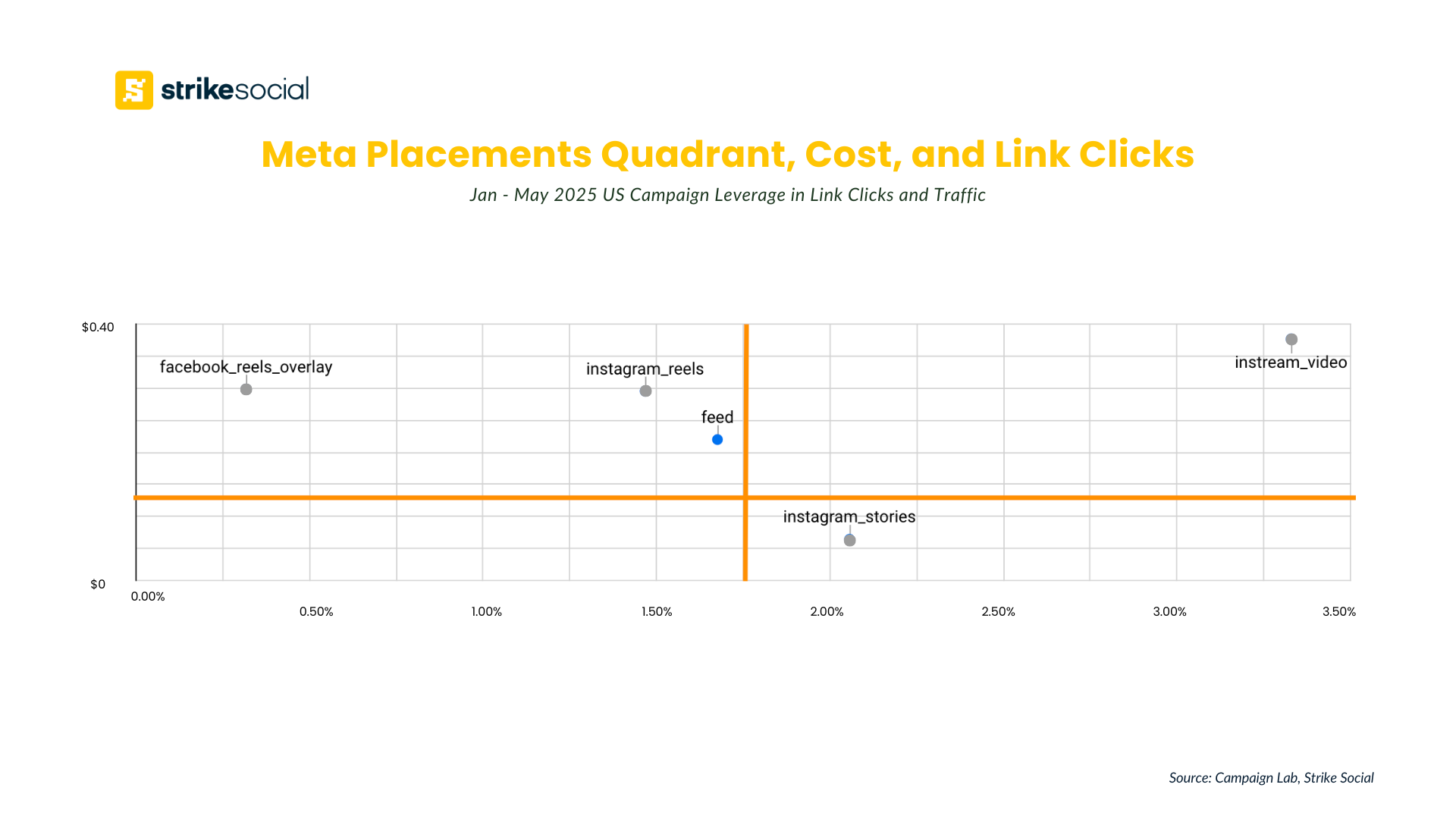
Feed economics are hard to ignore, showcasing a 20% cost-efficient CPLC and a 152% lift in Link Click-Through Rate compared to all other placements combined. The Facebook feed efficiency indicates that advertisers are not only saving money but also successfully directing higher-intent audiences to the next stage of their journey.
User behavior across the different content and sections on Facebook Feed indicates that users are already in “tap-and-read” mode, unlike the passive swipers in Reels or Stories. This contrasts sharply with the passive scrolling habits observed in Reels or Stories. Each piece of content curated by Facebook is strategically designed to maximize user engagement and retention.
The Feed serves as a high-quality inventory, drawing from users’ existing interests and acting as a gateway to other Facebook surfaces. Ultimately, the increased click-through and link click rates on the Feed enhance overall efficiency, generating favorable ad actions at lower bids.
Why It Matters for Media Planning
Whether running a bottom-funnel campaign or aiming to reach a wider audience, Feed ads offer advertisers advantages by delivering five qualified clicks for the price of four due to its 20% efficiency over other ad placements. This efficiency translates to a higher Link Click-Through Rate, withstanding seasonal spikes in ad costs without compromising campaign performance.
Thus, designing a media plan that positions Feed as part of the campaign’s foundational element maximizes qualified traffic at a lower cost. This strategy accelerates the learning process and enhances all subsequent targeting strategies. Leading to a more balanced cost with sustained performance effectiveness.
Ads on Feed Blends Organically, Super-Charging Performance
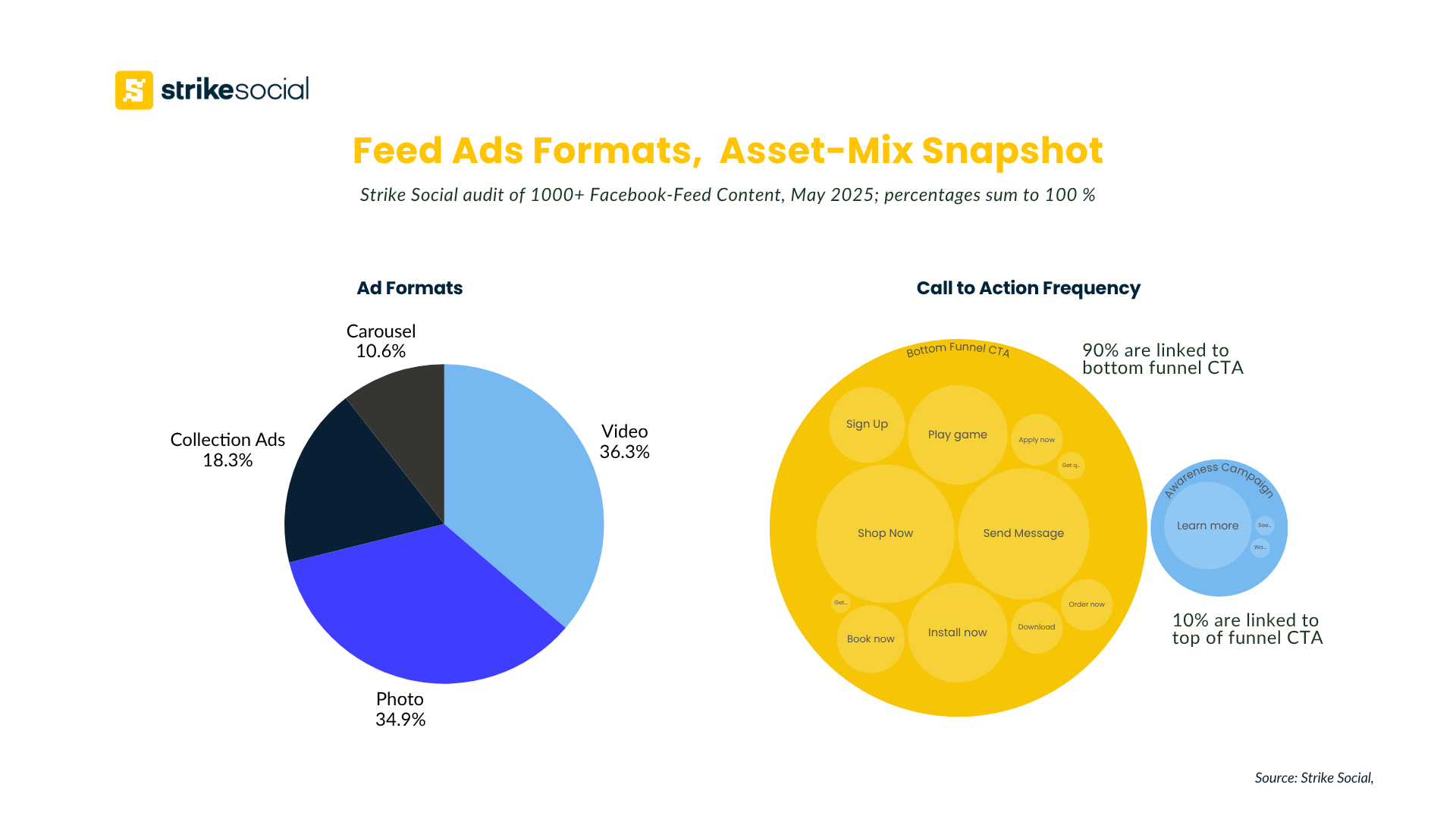
Unlike Reels or Stories, where static photos or product cards can feel disconnected from full-screen videos, the Feed allows ads to blend seamlessly with the surrounding content. This familiarity encourages users to keep their thumbs moving toward your call-to-action (CTA) instead of swiping past.
Strike Social’s internal study on different Feed content reveals that 70% of ad formats mimic native content norms, such as image and video ads, while non-native assets like Carousel and Collection ads make up roughly 30%. Although these formats differ slightly, the swipe interaction offers a natural and seamless way for users to scan multiple unique selling propositions (USPs) at once. Additionally, Carousel and Collection ads help reduce ad fatigue by enabling users to swipe through multiple products rather than increasing the frequency of individual ads.
Why It Matters for Media Planning
If most campaign assets are static or non-9×16 video, feed ad placement offers a more native, organic-feel spot for these types of ads, as blending seamlessly with the surrounding content can trigger more valuable ad engagement. Meta auctions reward ads that gather high ad engagement and longer ad stickiness.
For mid-funnel efforts, carousel ads and collection ads with swipeable elements work well in environments where stop-and-scroll behavior is more dominant than swiping away. Lastly, having boosted ads or UGC ads on feed increases ad authenticity.
Winning Strategies for Feed Ads in 2025
Even a highly crafted ad campaign can fall flat if its execution appears off-brand within the Feed. Since Feed ad placement is the most commonly used, it often receives less attention, with focus primarily on the more eye-catching formats like Reels and Video ads. Perhaps advertisers are neglecting desktop users, concentrating solely on mobile audiences.
Here are some common challenges faced by media buyers and strategies to overcome them and stay on track.
| Common Symptom | Likely Root Cause | Quick-Fix Checklist |
|---|---|---|
| Side edges clipped on mobile | Creative uploaded in 16 : 9 or any format wider than 4 : 5 | • Re-export at 1 : 1 (1080 × 1080 px).• Place all text/logo elements inside the central 80 % safe zone. |
| Top or bottom trimmed on desktop | Only a 4 : 5 asset provided | • Add a 1 : 1 backup (1080 × 1080 px)in the same ad.• Meta automatically serves the best ratio per device. |
| Image looks soft or pixelated | Source file < 1080 px on its shortest side or final file > 4 MB (Meta over-compresses) | • Re-export at 72 dpi, ≥ 1080 px, under 1.5 MB.• Save as high-quality JPG or PNG—not “web-optimised”. |
The Universal Safe-Zone Rule:
Keep logos, prices, and CTAs at least 54 px away from every edge of a 1080 × 1080 canvas.
This boundary prevents UI (profile pics, timestamps, action buttons) from covering important elements on any device. Download our free PSD/FIG safe-zone overlay in the Safe-Zone Guide and place it on top of every export.
When repurposing a Reel-Centric asset, it’s important to remember that captions and control icons typically cover the top and bottom 250 pixels of the screen. Making your message visible and impactful, place the main text within the central area of the video, specifically inside the middle 1080 by 1420 pixels zone.
Additionally, lock down aspect ratios and respect safe zones during the design process. By following these guidelines, your ads will appear sharp and professional, making a strong first impression whether users are scrolling quickly past or engaging with your content.
Let’s see those stats: What 1,000 Facebook Feed Items Tell Us About Ad Density, Brand Saturation, and Spend
To shed light on the outcry, “My Facebook Feed is filled with ads!” we decided to run an internal test. Over three days, we recorded the first 30 posts shown to six different Facebook users, capturing more than 1,000 pieces of content, including every ad, friend update, page post, and group post that appeared.
Here’s what the team has uncovered:
How many ads are there in someone’s Facebook Feed?
The straightforward answer depends on how users interact with ads and on the Meta ecosystem. Our sample shows ads occupied between 10% and 38% of the first thirty slots. To break this down: for someone who rarely engages with ads, an ad appears in their feed about 10% of the time. Conversely, the figure rises to as high as 38% for an active engager. Overall, our data shows that 24% of the content in feeds reflects ads, averaging between 2 and 3 ads for every 10 pieces of content.
In practical terms, Facebook’s auction favors brands that attract click-happy users by giving them more inventory. However, that comes with a catch: you’ll need fresher creative and tighter frequency controls to prevent high-engagement audiences from burning out and to ensure that the extra impressions you gain don’t turn into wasted spend.
Further Reading
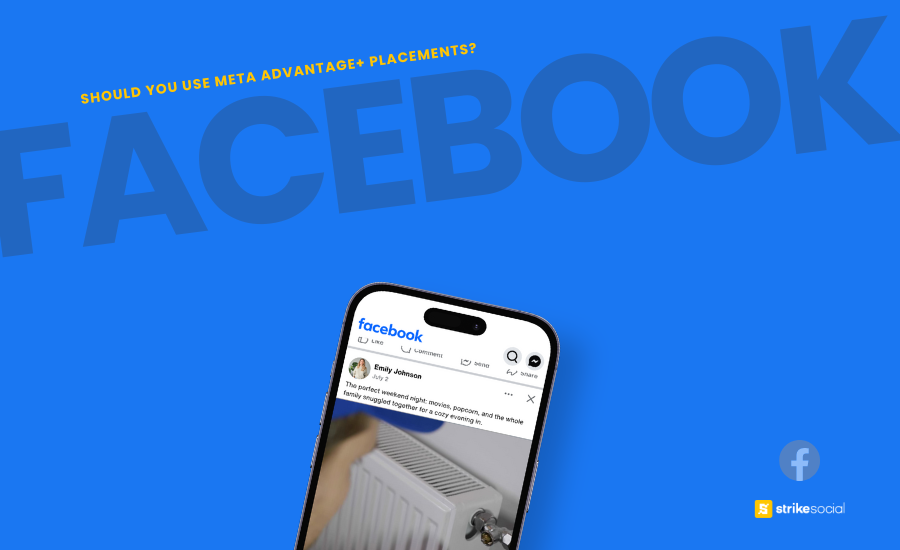
Meta Advantage+ Placements: Expand Your Reach or Stay Selective?
Meta Advantage+ Placements open the door to wider reach across its ecosystem. But should you hand over the reins, or guide your placements manually? We break down what each path offers.
Dissecting Content Feed Mix
This isn’t the Facebook we all knew 15 years ago. No longer is it the cozy timeline of friends’ updates that many remember. Today, each content scroll is typically interrupted by an ad 24% of the time. In our sample of over 1,000 items, only 18% of the feed consists of posts from friends, which is 10 points lower than the 28% from brand pages or digital creators. Meanwhile, 14% are from Facebook Groups, with the remaining content coming from surfaces like PYMK, AI cards, sections leading to Threads, Reels, or Stories.
This shift indicates that Facebook’s feed is now more structured around infotainment and less focused on social circles. A challenge presented to media buyers: competing for attention against highly polished ads and organic posts. The takeaway suggested that traditional banner ads won’t make it to the cut. To stand out, you need thumb-stopping visuals, concise copy, and a native scroll format that seamlessly blends in yet captures attention enough to click. In essence, design your content for this mixed economy of the feed, rather than the idealized “friends and family” environment many marketers still envision.
Perfect Balance of Eyes and Actions on Ads
When a new ad placement is released, the algorithm loosens up on it. Reels Overlay had gotten 31% of the share of spend. This is a mix of manual setup and Advantage+-led campaigns. Facebook Feed, commanding only 19.1 % of spend, quietly produced a nearly identical share of clicks and link-clicks, despite accounting for less than one-tenth of all impressions served.
| Placement | Share of Spend | Share of Impressions | Share of All Clicks | Share of Link Clicks |
|---|---|---|---|---|
| Reels Overlay | 30.51 % | 64.59 % | 23.90 % | 27.35 % |
| Facebook Feed | 19.08 % | 9.43 % | 21.29 % | 23.73 % |
A quick analysis reveals a significant efficiency gap. Although Reels Overlay ads dominate the placement, accounting for two out of every three ads, they have not generated substantial engagement. In contrast, the Facebook Feed received only one-fifth of the budget but delivered less than 10% of the impressions. However, despite these limited impressions, the Feed produced almost the same volume of clicks and link clicks as the higher-budget placement. This contrast highlights the Feed’s remarkable ability to convert limited reach into measurable engagement.
Why the Facebook Feed Remains a Crucial Ad Placement in Your 2025 Strategy
The Facebook Feed offers a scroll-native experience that is conversion-efficient and rich in first-party intent signals. It stands out as a placement that can seamlessly scale from upper-funnel reach to bottom-funnel action without requiring a format change.
Facebook feed ad density adapts to user behavior. For heavy clickers, the Feed may display up to four ads for every ten posts, while non-clickers encounter minimal interruptions from organic content. The ads served in users’ feeds are highly qualified, making them more likely to result in clicks.
The intent signal on Feed is clear, with a mix of high-quality inventory. Friends’ posts occupy only 18% of the timeline, whereas organic brand posts and digital creator content comprise nearly twice that amount, resulting in a more engaging user experience.
Lastly, efficiency favors ads on feed. With only 19% of your budget allocated, the Feed generates 21% of link clicks, almost matching the click volume of Reels Overlay. This impressive conversion rate transforms limited inventory into action at a higher density.
By mastering these fundamentals, your campaigns leveraging Feed ad placements will continue to yield strong returns, converting scrolls into clicks and clicks into revenue.
Leveraging Data and Global Workforce to Enhance Your Facebook Ads Strategy
The data snapshots in this post only scratch the surface. For a complete picture of Facebook cost and metric performance, grab the Strike Social 2025 Facebook Benchmark Report.
If you’re ready to turn those efficiencies into predictable outcomes, lean on a partner that lives in Meta’s auction every day. Strike Social, Meta’s certified partner, layers Advantage+ automations, proactive creative testing, and real-time bid management to squeeze every qualified click out of the Feed.Let’s work together to make your next campaign the case study everyone cites.

Article by
Franchette Brucelas, Strike Social’s Head of Operations
Franchette is the operational force behind Strike Social’s cross-regional performance success, overseeing campaigns across APAC, EMEA, and North America. Her leadership ensures delivery precision, platform strategy, and continuous improvement through close collaboration with sales, tech, and client teams.


